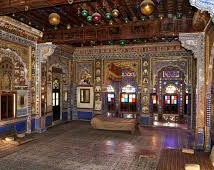Situated on the banks of river Yamuna, northwest of the Taj Mahal, this majestic fort was started by the Emperor Akbar, and it developed as a stronghold of the Mughal Empire under successive generations. This majestic fortress of red sandstone encompasses, within its 2.5- km-long enclosure walls, the imperial city of the Mughal rulers. It comprises many visionary palaces, such as the Jahangir Palace and the Khas Mahal, built by Shah Jahan; audience halls, such as the Diwan-i-Khas; and two very beautiful mosques.
Amar Singh gate towards the south is the entry point in the fort and the mammoth walls of the fort are 20 feet high. The building and structures inside the fort gives an impression of a city within the city. The marble pearl mosque inside the fort is one of the most stunningly beautiful mosques in India. Between the many pavilions, you find small well maintained gardens.
Diwan-e-Khas
This was the hall of private audience. This hall was also added by Shah Jahan. This hall is divided into two rooms connected by three arches and it was here that the famous peacock throne was kept before being shifted to Delhi by Aurangzeb and finally carried away to Iran.
Jehangir Mahal
Jahangir Mahal was the principal zenana palace, palace for women belonging to the royal household, used mainly by the Rajput wives of Akbar. A splendid gateway leads to an interior courtyard surrounded by grand halls covered with profuse carvings on stone, heavily fashioned brackets, piers, and crossbeams. This exotic medley and adventurous eclecticism suggests a daring approach in architecture.
Khas Mahal

In the Khas Mahal enclosure,built by Shahjahan, later Mughal architecture comes of age. The Khas Mahal is an airy edifice, overlooking the specially laid Angoori Bagh, grape garden; a simple formal Mughal garden. Windows closed with jali (intricately perforated decorative stone screens) present fabulous view of the riverfront. The two copper-roofed pavilions built in the Bengali traditions were meant for prominent ladies of the harem. On three sides of this garden are residential quarters of women.
Sheesh Mahal
Mirror palace or the royal hammam (bath) is decorated with myriad glass pieces and a central fountain.
Machhi Bhawan
Opposite to the Diwan-E-Khas is the machhi bhawan, the fish enclosure. The emperor sat on the white marble platform facing the enclosure. It once contained pools and marble fountains, which were carried off by the Jat Raja Suraj Mal to his palace at Deeg.
Musamman Burj
On the left of the Khaas Mahal is the Musamman Burj built by Shahjahan. It is a beautiful octagonal tower with an open pavilion. With its openness, elevation and the benefit of cool evening breezes flowing in off the Yamuna River, this could be well have been used also as the emperor's bedroom. This is where Shah Jahan lay on his death bed, gazing at Taj Mahal.
The Three Mosques
There are three mosques within the Fort. Nagina Masjid has three graceful domes and was used by the women of the harem. Then, there is the tiny Mina Masjid, located near the Mussaman Burj which is now closed to the public. The third is the Moti Masjid or the Pearl Mosque, which was built by Shahjahan for his personal use.